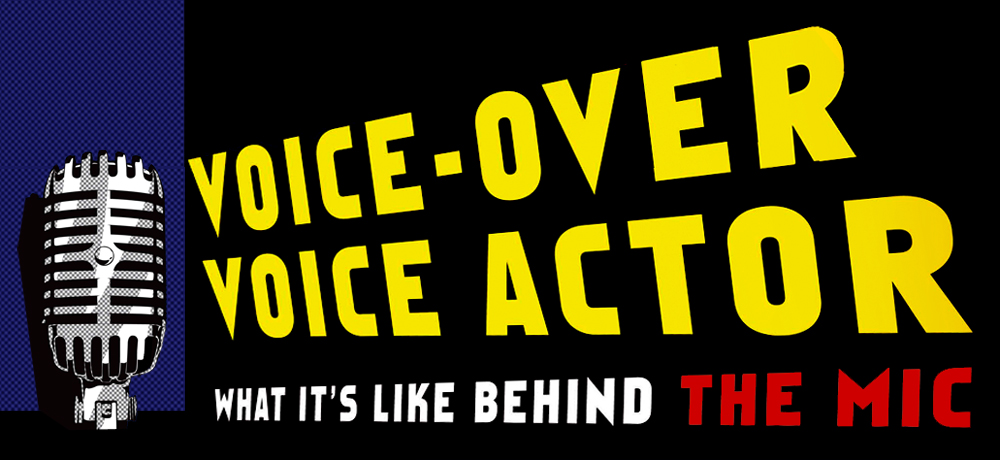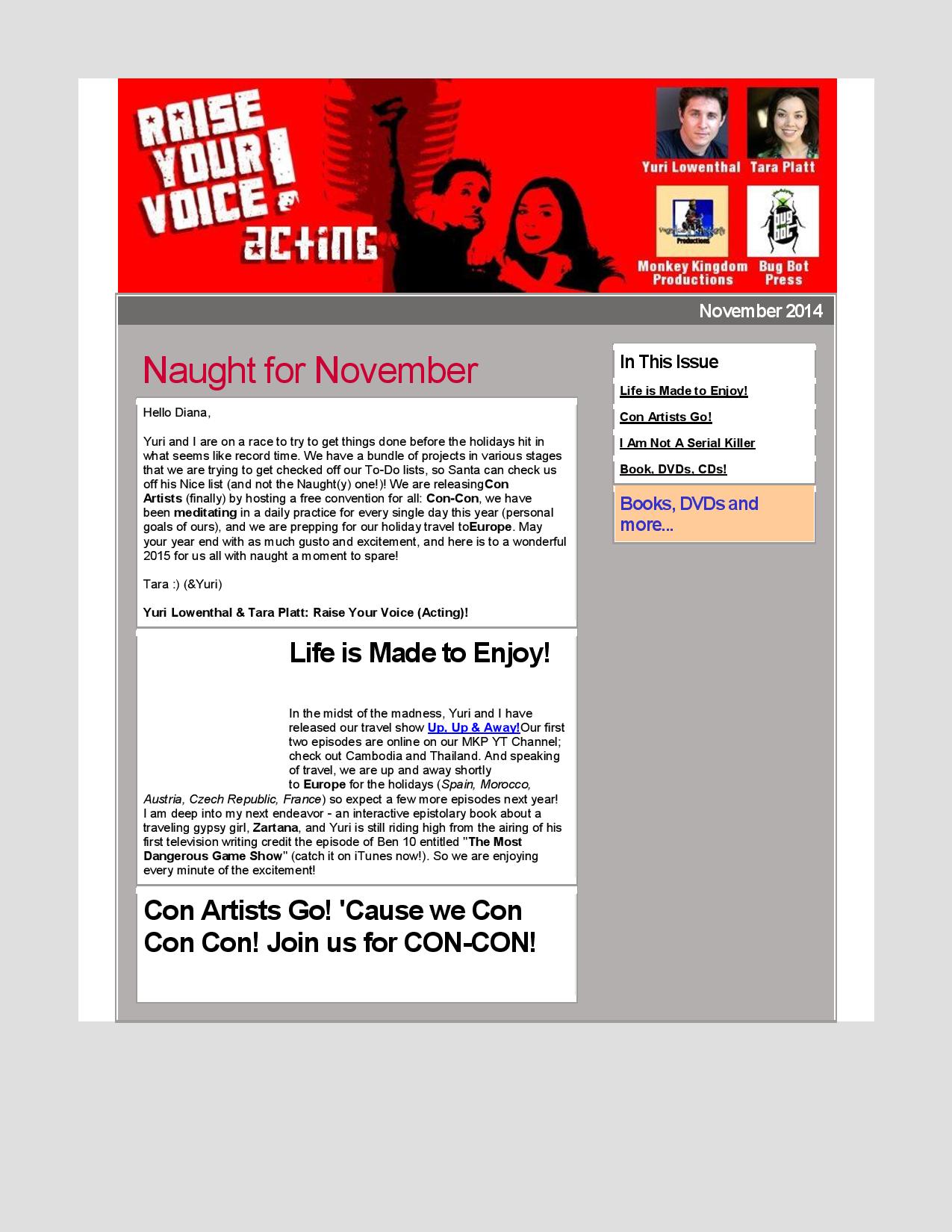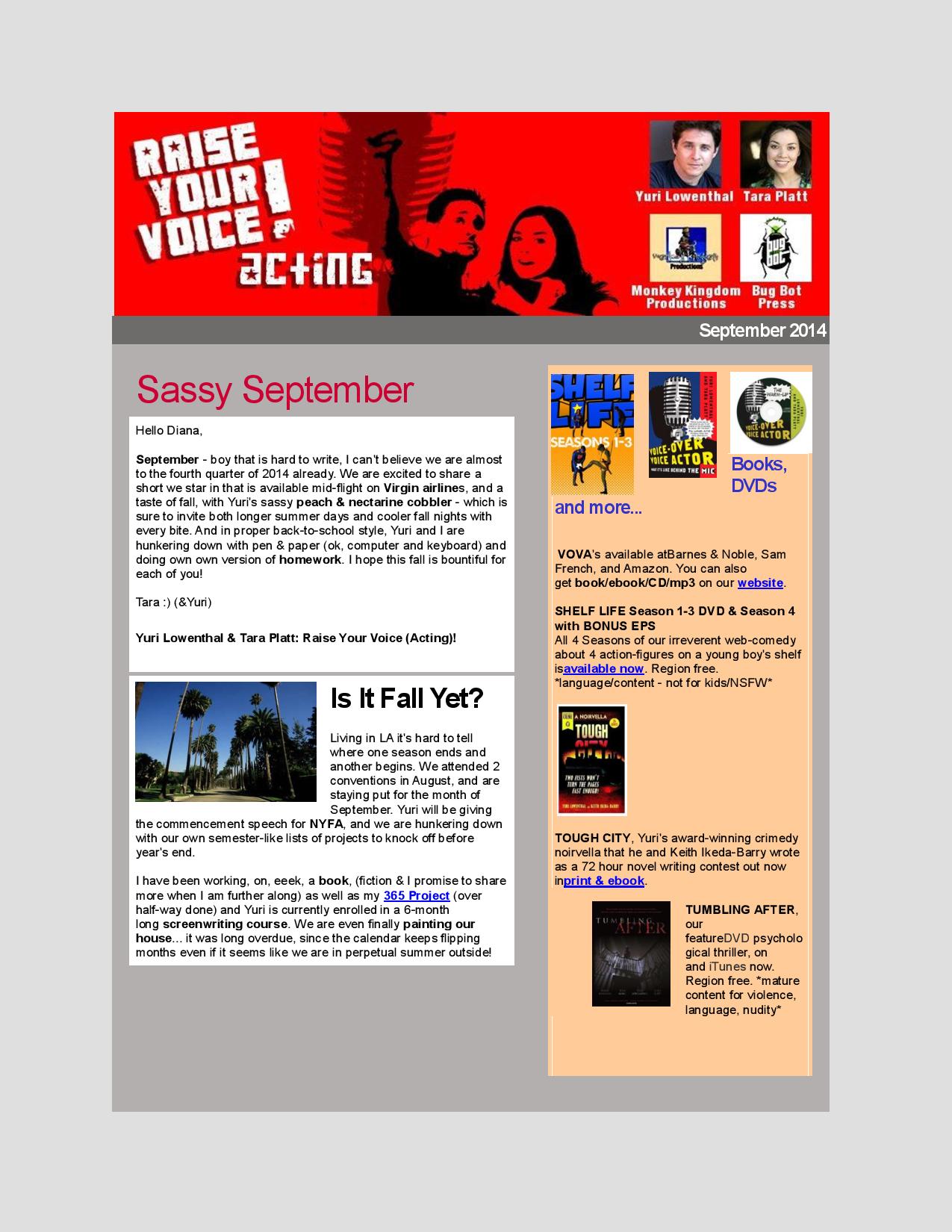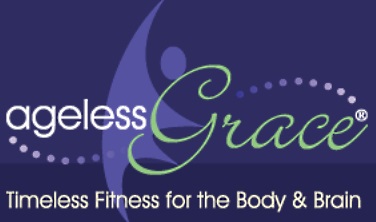PeanutButterStoryTime
Yuri and Tara are making use of their reading skills and hosting a fun weekly bedtime story show on Unlocked called PeanutButterStoryTime. Join them Tuesday nights 8p PST on Unlocked

A Peek Into The Secret World Of The Voice Actor
Interested in pursuing a career in VO? Curious what goes on behind the scenes in a business where people talk funny for money? This book offers a fun and comprehensive look at what it takes, what goes on and what it’s like behind the mic from two working pros who started from scratch.
Yuri and Tara are making use of their reading skills and hosting a fun weekly bedtime story show on Unlocked called PeanutButterStoryTime. Join them Tuesday nights 8p PST on Unlocked
Check out our latest newsletter, below. There's a sign up button over on your right if you'd like to receive it!
Yuri and I are on a race to try to get things done before the holidays hit in what seems like record time. We have a bundle of projects in various stages that we are trying to get checked off our To-Do lists, so Santa can check us off his Nice list (and not the Naught(y) one!)! We are releasing Con Artists (finally) by hosting a free convention for all: Con-Con, we have been meditating in a daily practice for every single day this year (personal goals of ours), and we are prepping for our holiday travel to Europe. May your year end with as much gusto and excitement, and here is to a wonderful 2015 for us all with naught a moment to spare!

Here is an excerpt from our book, Voice Over Voice Actor: What it’s like behind the mic. Hope you find it helpful!
“But I haven’t done any work yet! What am I supposed to put on my reel?” you may ask, your brow furrowing in panic and dismay. Relax that brow. A demo reel doesn’t have to be from actual work you have already done; more often than not, everything on a demo is totally fabricated. As a matter of fact, even if you do have some real material to put on your reel, you may want to put made-up stuff on it anyway. This will allow you to focus the demo and highlight the qualities that you want to showcase. After all, demo can also mean demonstration of what you can do, not necessarily what you have done.
Now here’s a thing that’s going to highlight the weirdness of the entertainment biz: all agents know that actors make up most of what’s on their demos, especially when just starting out; but they still want to be fooled. So that’s what you’ve gotta do. Fool ‘em as best you can. Let’s see how you can do that.
What are you going to record? Well, first we're going to caution you against copying things directly from other commercial spots you hear or shows you see. The reason for that is this: as big as you think this world is, people are paying attention; and with people like casting directors and agents, it's their job to pay attention.
You don't want to record yourself doing a McDonald's spot you heard on the radio or shouting out the catchphrase of a popular animated character, and then send it to an agency whose client actually did record that spot or character. Your demo will immediately be outed and possibly thrown away. That’s not to say it's definitely going to happen, but we feel that in this situation, it's better to be safe than sorry, especially when there are easy ways to cover your tracks.
This seems like a good place to mention something else that we feel is important and will serve you throughout your long career in this business: don't lie about the work you've done. There might be a temptation to say that you worked on things you didn't work on so you seem more experienced to a possible employer, especially in the beginning when you don't have any credits to speak of. Don't. Don't do it.
We're not saying you should open every conversation with, “Okay, now, I just want you to know that I have never done this before.” If they don't ask, let 'em think what they want. But don't put titles that you didn't work on, on your résumé because you'll be working in a very tight circle of people. And if the person reading your résumé didn't cast it, odds are he or she knows the person who did, or the director; and being caught in a lie is a great way to get remembered for all the wrong reasons. Don't get caught up in trying to make people think you're much more experienced than you are. If they like you, they're going to want to be the one who discovered you. Let 'em discover you.
After reading the last few paragraphs, you may be saying to yourself, Hey, first they're telling me to fake it and now they're telling me not to lie. What gives? Sure, our advice on these two issues can be seen as inconsistent, but trust us on this one. Acting is a business of illusion, and the demo is an accepted bending of the rules in this world. Taking credit for things you did not do, not so much.
Now that we've hopefully made that clear, let's get back to making your demo sound as legit as you can. But if I can't copy real things, how am I supposed to know what to record? you may ask. Well, here's another place where we're going to ask you to employ that powerful imagination of yours. Look at some real stuff … and then mess with it.
To create commercial copy for your reel, go pick up a magazine and flip through the ads. Print ads are written differently than radio or TV ads, so you won't ever have to worry about someone already having recorded this spot. Now mess with it, rewrite it a bit, and make it your own.
Do the same for animation and video game bits. Watch, listen, play, take notes. Then mess with it, riff on it, make it your own. If you really hate writing, find a friend who's good at it and see if he or she will help you. Before you know it, you'll have scripts to record. And you don't need many.
Let's say you've recorded your demo as professionally as you can. Now, you'll want someone (an audio engineer) to spend time mixing it and sweetening it with effects and music, so that it sounds as if the spots were pulled from actual shows or commercials. The engineer will work with each clip you've recorded as if it were a real spot, and make it sound as good as possible; then you'll work together to pull your favorite section of each spot.
You'll want your demo to run about sixty seconds total, so you'll have to pick only the best part from each spot. Agents and casting directors are busy people. They're not going to have time to listen to a five-minute demo, so you gotta hook 'em quickly and leave 'em wanting more.
Another trick that engineers often use to help the demo reel sound more realistic is to change the recording levels and settings between the different spots. This way, even if you record them back-to-back in one session, the sound quality will be slightly different from spot to spot, just as if you had recorded each spot at a different time in a different studio with a different engineer. You can even help the engineer achieve this effect by changing your position slightly from script to script. It may seem funny, but sound is a finicky thing; and little things, even moving an inch back from the mic, or an inch left or right, can drastically affect how your voice is recorded. That's why, if you record at a certain studio regularly, you may notice the mic setup is always the same in order to maintain consistency in recording.
All of these things will add up to a professional sounding demo, which will be key in helping to open the doors that lead to work. Don't be afraid to spend both time and money on your demo, but also don't be afraid to shop around. If a deal seems too good to be true, make sure it isn’t by first doing a little research on your own. If the Internet's good for something, it's research. Well, research and downloading videos of cats doing cute things.
+++++++++++++++++++++++++++++++++++++++++++++++++++++++++++++++++++
Check out our VoiceOverVoiceActor website for more tips and exercises. We post daily VO tips on Facebook and Twitter, and our book, Voice Over Voice Actor: What it’s like behind the mic includes a wealth of exercises to build your voice and keep it ready for a successful voice over career!
 Other great voiceover artists can be a source of inspiration!
Other great voiceover artists can be a source of inspiration!
Next in our series of voiceover greats, we suggest you check out the wonderfully talented Rob Paulsen, who says he is "Getting paid to do what got me in trouble in the 7th grade."
Rob is best known as the voice of Yakko Warner and Dr. Otto Scratchansniff from Animaniacs, Raphael from Teenage Mutant Ninja Turtles, and Pinky from Pinky and the Brain. In his long and lustrous career, Rob has played more than 250 different animated characters and thousands of commercials.
From Rob's website:
"Born in Detroit, Rob Paulsen spent his childhood in Livonia and Rochester, attending Junior and Senior high school in Grand Blanc, Michigan. Rob loved cartoons like most kids but aspired to be a professional hockey player. “Fortunately, thanks to some big, strong, kid from Winnipeg who drilled me so hard my ears are still ringing, I learned around age 18 I had neither the talent nor the temperament to make a living playing hockey. So, I turned to my other passions: singing and acting.”
The goal of bringing absolute believability to a fictional character, live-action or animated, is what every actor strives for. Those who are committed to their career and who combine experience, passion and skill are likely to succeed.
Those gifted with exceptional talent who focus on maximizing their potential by finding their own niche, quickly break away from the pack...."
READ MORE
 Here's a great tip and exercise for voiceover artists: use TV commercials as a source of practice. Really listen to the commercials on your TV or radio. When you find a good commercial you like, try to parrot the VO actor who is speaking the lines. You'll be repeating the words, of course, but also try to copy, as exactly as you can, the nuances, the tone, the inflections he or she uses, and the musicality.
Here's a great tip and exercise for voiceover artists: use TV commercials as a source of practice. Really listen to the commercials on your TV or radio. When you find a good commercial you like, try to parrot the VO actor who is speaking the lines. You'll be repeating the words, of course, but also try to copy, as exactly as you can, the nuances, the tone, the inflections he or she uses, and the musicality.
Then mute or turn off the TV or radio and grab any random bit of text, such as an ad in a piece of mail or magazine. Try to bring the new tone and vocal patterns you've been copying to these new words. You will be using the style you've been mimicking with this new material.
This will really start to train your ear and attune you to what is currently “hot” in the advertising world. And it gets you practicing, reading aloud, and using your voice in new ways.
And it's fun! Enjoy!

We all have our happy places when it comes to acting. Some of us revel in playing the hero or heroine, while others feel perfectly at home twirling our mustaches as the villain. Either way, it’s good to know where your comfort zone is and where you enjoy playing. It pays to know your strengths so you can take advantage of them and carve out a niche for yourself in the area you may be best suited to. But it’s also good to be aware of your strengths so that you can take time to work on the areas you aren’t as skilled in. In this way, you expand your repertoire and make yourself a more versatile, interesting, and employable actor.
It’s certainly not our intent to detract from the idea of doing one specific thing very well. That’s extremely important. It’s just that, if that one thing goes out of style, you want to have something to fall back on. And just because you’re good at one thing doesn’t mean you can’t learn to do other things equally well. For example, our good friend, the otherworldly talented actor Dee Bradley Baker, is known far and wide for his creature voices, monster babble, and alien squawking, and that’s what people tend to hire him for. But when called upon to do so, he also turns in a very moving, believable, human performance.
The best actors push their personal boundaries and continue to grow throughout the life of their entire careers; filling them up with memorable, interesting, and bold characters. If you feel you’re having a hard time pushing your boundaries on your own, get into a class where it will be someone else’s job to give you a friendly shove in the right direction. Classes can hold you accountable for your work in a way you often can’t do on your own.
Use your auditions as a place where you always push your boundaries and expand your comfort zone a little. Open yourself up to all possibilities. Widen the circle you play in.
+++++++++++++++++++++++++++++++++++++++++++++++++++++++++++++++++++
Check out our VoiceOverVoiceActor website for more tips and exercises. We post daily VO tips on Facebook and Twitter, and our book, Voice Over Voice Actor: What it’s like behind the mic includes a wealth of exercises to build your voice and keep it ready for a successful voice over career!
Check out our latest newsletter, below. There's a sign up button over on your right if you'd like to receive it!
September - boy that is hard to write, I can't believe we are almost to the fourth quarter of 2014 already. We are excited to share a short we star in that is available mid-flight on Virgin airlines, and a taste of fall, with Yuri's sassy peach & nectarine cobbler - which is sure to invite both longer summer days and cooler fall nights with every bite. And in proper back-to-school style, Yuri and I are hunkering down with pen & paper (ok, computer and keyboard) and doing own own version of homework. I hope this fall is bountiful for each of you!
Tara :) (&Yuri)

 It is good to study other terrific voiceover artists to really learn the ropes. There are many success stories out there in the voice over arena to inspire you!
It is good to study other terrific voiceover artists to really learn the ropes. There are many success stories out there in the voice over arena to inspire you!
Here is great example: Dee Bradley Baker
From his website: "Dee Bradley Baker is one of the most versatile and sought after A-list voice actors working today. His voice is seemingly everywhere, featured in literally hundreds of television shows, movies and top video games. Over the past two decades, Dee has earned an extraordinary reputation among show creators and fans alike with his chameleon-like acting skills and his wide range of realistic creature sounds, from tiny birds and insects to gigantic monsters.
Dee is currently featured on Fox's Emmy-nominated series “American Dad” (Klaus the goldfish), as well as on Nickelodeon's "Avatar: The Legend of Korra" (Tarrlok, Pabu and Nala), “SpongeBob Squarepants” (Squilliam, etc.), Cartoon Network's hit series “Ben 10: Alien Force” (the super aliens), and “Adventure Time” (Cinnamon Bun, etc.).
Dee appears regularly on many Disney Television cartoons. He currently voices Perry the Platypus in the mega-hit series “Phineas and Ferb,” and appears on "The Mickey Mouse Clubhouse," "Gravity Falls," and "Jake and the Neverland Pirates." In addition, his creature vocals are featured in two “Tinkerbell” movies.
Fans of the Walt Disney theme parks may be surprised to learn that Dee voices the parrot on the "Pirates of the Caribbean" ride and Boba Fett for the newly retooled "Star Tours 3D" attraction..."
ANOTHER GOOD INTERVIEW
Voice of a Geek: An Interview With Dee Bradley Baker
By John Booth
MORE INFO:
Dee Bradley Baker was born on August 31, 1962 in Indiana, USA. He is an actor, known for American Dad! (2005), Legends of the Hidden Temple (1993) and ...
Dee Bradley Baker (born August 31, 1962) is an American voice actor and singer
Dee's helpful site for aspiring voice actors: http://iwanttobeavoiceactor.com/ If you want to follow my updates ...
We asked voice actor Dee Bradley Baker at Disney's D23 Expo to do the voices for Perry The Plattypus from ...
 There are several things that we think you should know before you start auditioning. One of these things is the importance of creating a strong character. We’ve noticed that the people who really succeed in this business are generally good actors first, good voice-over actors second. Strangely enough, when juggling all the balls of voice-over, one of the easiest to drop is the acting. Acting is where the most fun is, so who wants to drop that ball?
There are several things that we think you should know before you start auditioning. One of these things is the importance of creating a strong character. We’ve noticed that the people who really succeed in this business are generally good actors first, good voice-over actors second. Strangely enough, when juggling all the balls of voice-over, one of the easiest to drop is the acting. Acting is where the most fun is, so who wants to drop that ball?
Creating a character is so much more than saying the words in the right order, or in a unique and interesting way. Creating a character is really about using your imagination to create the universe the character lives in, and then saying “yes, and,” to that universe. This yes, and, theory pops up a lot in improvisational comedy (improv) and theatre classes, so you may have heard it bandied about before now.
Put simply, one of the fundamental keys to good improv (and good acting in general) is agreeing to the scenario (yes) and then adding something (and) to take it to the next level. The more you say “no, but,” the harder it is to get to where you’re going, and the less interesting it’ll be for everyone involved. You’ll find that by your being specific about the world your character lives in, the type of character that would reside in that world quickly becomes clear to you. The character’s personality you end up creating this way will be real and honest, no matter how outlandish and wild the character’s reality might be.
Who’s to say that a talking sponge can’t have friends under the sea and wear geometrically formed pants? We bet a lot of people said “no, but” to this idea once upon a time, but the success of that show goes on and on, because the right people said, “yes, and … ”
Bringing a character to life through your own creativity, truth, and ability is what being an actor is all about. You get to live different lives and have experiences totally foreign to your own. Showing how much you love this part (by doing it) will become invaluable not only once you’ve got the job, but it’s going to help you get cast. Being able to create an interesting character at an audition shows that you’ll be able to create an interesting character if hired.
+++++++++++++++++++++++++++++++++++++++++++++++++++++++++++++++++++
Check out our VoiceOverVoiceActor website for more tips and exercises. We post daily VO tips on Facebook and Twitter, and our book, Voice Over Voice Actor: What it’s like behind the mic includes a wealth of exercises to build your voice and keep it ready for a successful voice over career!
 Vocal chords are vocal chords, whether we use them for singing or speaking (or shouting! :-) The voice is an instrument and good health and neuro plasticity can be across the board.
Vocal chords are vocal chords, whether we use them for singing or speaking (or shouting! :-) The voice is an instrument and good health and neuro plasticity can be across the board.
Here is a good article we found recently, entitled:
"Singing and Neuroplasticity: 6 Tips for Ageless Singing"
By: Lisa Haupert, Ageless Grace Trainer and Shameless Singing Vocal Coach
Ageless Singing. Strong Singing. You singing.
There is a given with aging. Every year that you are alive, you are a year older. That’s all.
Most of the specifics about how we age are in large part, up to us. Yes, we can get a disease. Yes, gravity wins out on our skin and things might sag a bit. But for the most part, how we age is up to what habits we practice, and our mind-set.
When it comes to the voice, there are some specific givens about aging.
Check out our latest newsletter, below. There's a sign up button over on your right if you'd like to receive it!
We just returned from our Australian adventures and it is back to work and back to summer! Thankfully Yuri and I have been working like mad in VO, comics and videos, and we are deep in post on Topsy McGee. Yuri has been writing a bunch and we are enjoying the long days and the warm nights!
I hope July is jammed full of as much fun as you and your inner childlike-wonderment-filled self can make it!!
Tara :) (&Yuri)
 This exercise is to help you begin to compile your own practice copy for you to work on and then eventually use to create your commercial or animation demo reel.
This exercise is to help you begin to compile your own practice copy for you to work on and then eventually use to create your commercial or animation demo reel.
For commercial copy, find magazines, see which ads visually pop out at you and write down the advertisement (or if the magazine is yours, pull the page out). Remember that print copy reads differently from commercial audio copy, so use the print as a starting point and then make slight adjustments to help the line flow.
To build animation copy, find an inanimate object in your house, then begin to write a monologue or conversation this object/character might have with you about its needs or hopes or dreams. Another wonderful way to create animation copy is to write down your favorite characters from animated shows, then rename them and make changes to what you know of their experiences, then try building a history or story for them that you find interesting.
Note which type of ad goes with the different types of commercial types (hard sell, soft sell, partner read, tag, etc.) also review your animation copy to see what types of characters you’re showing off and make sure you have some variety that works with your voice.
Put all your found (and massaged) copy into a binder, and practice randomly flipping to different pieces and reading and performing them as you would if you were in the booth.
Wonderful. You’ve had the chance to hone your unique vocal qualities and become more familiar with your natural voice. You’ve also probably gotten to see how your body reacts to a warm-up and how that can better prepare your voice for a session. You’ve read copy and made choices and have begun the process of building your own personal stack of practice copy that you can use as you move toward making your demo reel.
Voice-over isn't like it used to be where only 'certain' voices worked, now there are voices of all kinds and varieties to make up the spice of life. Basically, if you are a solid actor, are professional and considerate and you have good mic technique there is no reason you can't work in VO, of course, someone would have to hire you, so you'd need your demo reel ($$$$, time, energy) and most likely you will need to secure an agent to represent you and get you auditions (time/energy) as well as giving yourself as much as an edge as possible by taking classes, practicing your craft, knowing your voice and how to take care of it; so planning a career in voice-over is an investment.
The wonderful world of voice-over allows you to create amazing characters, to teach, to entertain, to offer new alternatives and to go on a whole new adventure. Remember, voice acting just “acting” without the bonus of using your facial expressions or body language to convey something visually, so your intention has to come across with just your voice helped by your imagination. And we all have one of those…
One of the best ways to learn about the art of voiceover is to study the "masters." One of the greats is Steve Blum. Steven Jay "Steve" Blum is an American voice artist known for his wonderful, deep voice. You've heard him on X-Men, and on many video games. He debuted in the early 90s in the animated series of Guyver, before which he had never done any acting. As he tells it, getting into voiceover work was an accident. He was discovered doing "crotchety" voices in a mailroom.
Steve was recently interviewed by Michael Worthan, of ComicBookTherapy.com. You can check it out here: READ MORE
“I KNOW THAT VOICE” An interview with Steve Blum!
by Michael Worthan
This is a short excerpt from, as Michael puts it, "...my very awesome interview with Steve Blum, a voice actor that has been in everything from Big-O as lead character Roger Smith to Wolverine and the X-Men as Wolverine himself. He has voiced more than 261 credited video game voices, and is the voice of Starscream in Transformers:
Question: "People always make assumptions about voice acting and what it really is, what is one thing you’d like the general public to know about your profession that they may not know already?
Answer from Steve: "That most of our time is actually spent driving, auditioning and reading descriptions of characters we’re auditioning for. "
Also, here is Youtube video of Steve doing his thing! Such a talent...
Check out our latest newsletter, below. There's a sign up button over on your right if you'd like to receive it!
We are well into spring with May in full bloom. I hope you are finding love (of yourself, of life, of others) and generally enjoying the beautiful weather. You can even use hypnosis to help move you toward a more happy life! I have been fortunate to book several commercials, so let me know if I appear on a screen near you. Yuri has had a wonderful run of some new VO projects and been hard at work writing (he even won a few awards) and is working on a couple of scripts and we are headed to OZ on a summer convention adventure! May your May be bountiful and fun!
Tara :) (&Yuri)
Yuri Lowenthal & Tara Platt: Raise Your Voice (Acting)!
 One great way of getting your ear (and then your voice) attuned to a variety of voices, inflections, accents and qualities is to practice people watching and people-listening.
One great way of getting your ear (and then your voice) attuned to a variety of voices, inflections, accents and qualities is to practice people watching and people-listening.
Find a fairly busy spot, like a mall, a zoo, a crowded lobby, café, etc, sit yourself down, and observe. Listen to how different people talk, take note of their pauses, inflections, their unique affectations and things you find interesting about them. Without appearing creepy, you might even pay attention to their mouths to see if there’s something specific they’re doing to create sounds.
If you think it might help, bring a note pad along so you can take notes on things you want to remember. Consider also bringing your quality check list with you so you can quantify for yourself the characteristics of the voices you’re hearing. In case you haven’t built a quality list yet, here are some examples to start with. Use them as a jumping-off point and add your own!
Calm Pointed Sincere Flustered Agitated Loving
Hypnotic Polite Warm Shrill Distant Brash
See how many different qualities a particular person’s voice might have: perhaps they have a calm, sincere, loving, polite voice, or maybe their voice is pointed and agitated. Mix and match to best describe the voice you are listening to, or add any qualities you become aware of that aren’t yet on your list.
Happy people listening!
 Here's a helpful voiceover exercise:
Here's a helpful voiceover exercise:We call it the "chewing hum." It can warm up the different areas where your voice will resonate. Once again, when your voice resonates, it bounces around a certain area of your body, whether that’s up in your face, nose or head area, your throat, or your chest or belly.
Here's what you do:
1. Keep your mouth and lips closed and begin to hum.
2. Start chewing, as if you were eating something tasty, as you keep humming.
3. Now use your hands to feel the vibration in the front of your face, your nose, your cheeks, and gently allow your hands to move to your neck and throat, and perhaps even onto your belly so that you can feel how your voice resonates in different areas of your body.
Now to begin to identify where your voice is resonating, let’s concentrate on specific sounds that tend to resonate in different areas. Certain sounds we create generally vibrate more toward the head, while others, because we use different muscles to make them, may vibrate lower, toward the belly.
If you can learn to control where you choose to place your voice, you can begin to use it in more powerful and interesting ways.
We are regularly asked about how to use a mic correctly, so here are our guidelines, again. Keep working on it, and soon it will be comfortable and second nature.
Tips for Microphone Technique
The mic can be rather daunting when you first start out in voice-over! Practicing at home with one will help to reduce the newness of it, and the distraction from it.
Here are some tips to get you started.
PROXIMITY
Find your own comfort zone, with regard to proximity. Many voice-over artists will angle slight to the right or left of the mic, for two reasons:
1) This can reduce or eliminate pops from plosive sounds like t, b, or p. When you're in a session, engineers can help by putting a “pop shield,” a stocking device or foam shield, in front of the mic. But if you angle- speak slightly across the mic - you create a similar effect to a pop screen.
2) You will be able to see and read your copy off to the right or left, without the mic being right in front of it.
VOLUME
Well, the mic is there to amplify the sound, so you can be as soft or loud as the job requires, but you need to work with the mic to create this. If you are recording yourself, make sure you are getting a solid wave form, and if you are working with an engineer s/he will do this by first getting a good level of your planned volume before recording the take. You can’t speak softly while the engineer gets a good level, and then shout during your take!
Every different session will call for something different in the way of volume . For example, if you want low, deep sounds from your voice it can help to get very close to the to the mic, perhaps two to three inches. If you know you are going to really project, and speak louder, stand back, seven to nine inches from the mic, so your voice doesn’t distort.
Then trust the mic and your own voice and skill. If you need drama and a “dark” interpretation, you might try a whisper, or near-whisper. And if it is comedy, use a little more level and smile the whole time you are speaking. It is amazing that a smile can come right through the microphone to the listener!
LIGHTING
You must be able to see well, to read your copy! Make sure you are well prepared with contacts or reading glasses if you need them, and some artists even carry a small clip-on light, which runs on a battery, to attach to the stand holding your copy. Lighting must be ample to reduce the possibility of unnecessary errors when you read. In many studios you can ask to increase the level of light if it isn't bright enough for you.
TECHNIQUE AND SKILL
Do your breathing exercises. Practice reading all kinds of different material at home in front of the mic. Try things and experiment at home to learn what your real strengths are. And stretch yourself to try new things. Try different pitches, different volumes, mimic cartoon characters or famous actors or comics. Read out loud in front of the mic and record it if you can, to listen back - you will learn so much from hearing your own work.
The more you develop and then employ your microphone technique and skill, the less the engineer and producer have to rely on enhancements in the studio. The less they work, the faster and easier the session, and the more likely you are to be re-hired! Plus, comfort and skill with the microphone shows your professionalism, getting the job done well and quickly, which is the producer’s goal!
Check out our latest newsletter, below. There's a sign up button over on your right if you'd like to receive it!
I am so very excited that it is March, and not just 'cause that means a Happy Birthday to Sir Yuri, who I am just so happy was born and is in existence. Birthdays in general bring me joy! My own goal this year is to take more time for myself and practice meditation and yoga more frequently (which I am pleased to report I have been implementing). I am doing a personal 365 Project on self love and I even got all woo-woo and did a 10 day International EFT Summit, on energy meridians and moving emotions and limiting beliefs stuck in the body! Hooray for space in life to pursue self-care!
Tara :) (&Yuri)
Yuri Lowenthal & Tara Platt: Raise Your Voice (Acting)!
 Many people snidely call this schmooooozing, but the truth is, meeting people and developing relationships is how things get done in the entertainment business. Practicing good solid networking skills can help you move forward quickly and consciously toward the next level of your career.
Many people snidely call this schmooooozing, but the truth is, meeting people and developing relationships is how things get done in the entertainment business. Practicing good solid networking skills can help you move forward quickly and consciously toward the next level of your career.
Networking facilitates your being in the right place at the right time. This is part of the preparation + opportunity (right place at the right time) = success equation. Prepare yourself, and then put yourself in situations where you can mingle and meet people. Sometimes you can target the people you want to work with. But honestly, you never know where a job or an important friendship is going to come from. So don’t limit your interactions.
How do you go about schmoozing? Well, first off, let’s stop calling it that. Let’s opt for networking. The word schmoozing has always carried a negative connotation to us because it implies that you’re forcing yourself onto other people for the sole purpose of getting something from them; and that’s just kind of slimy. That’s probably why a lot of actors have trouble networking – because when it’s called schmoozing, they feel like they’re doing something gross. The less pressure you put on meeting people, the easier it’s going to be, and the better it’ll probably work out.
Where do you go to network? There are a variety of places to go and ways to make connections happen. Search for networking events and social gatherings specifically geared toward voice-over and voice acting or to entertainment in general. These events are often listed in entertainment trade papers and on Web sites, and will certainly be more plentiful in big cities like New York and Los Angeles.
Don’t look just for parties (which are sometimes hard to get into). Find out where the people that you would like to work with hang out, and go there. Get yourself in the same circles they’re in and see what happens. You don’t have to be in a big city to make this work. You can go out with friends who are also working in the business, and meet the people they know. If you don’t know anyone else who’s interested in voice acting or in what you want to be doing, then find them.
Put an ad in a local paper or post it on an online site, somewhere like craigslist, MeeptUp, or Facebook. Set up a gathering for people interested in the same things you’re interested in. Build a support group, if you will. Things happen much faster (and it’s usually more fun) if you’ve got a whole group working at it. Who knows, the group you assemble might end up producing a cartoon together.
If you network well, and don’t put pressure on a specific outcome, it won’t be perceived as schmoozy. Still it’s not always the easiest thing for some people to do. Networking might not come naturally for you, so pay attention to people who are good at it and learn from them. In the end, being yourself is the best thing you can do when you meet and socialize with people professionally. You don’t need to try to act cool so they’ll like you. Remember you have as much to offer them as they have to offer you.
Networking should never be about what you can get from others. Treat them as you would your friends, and be friendly and personable. You just may be someone they will want to befriend and (who knows?) maybe work with one day.
And don’t forget your cards! A networking event is a perfect opportunity to get your business cards into people’s hands. Think of this as sowing seeds.
You may have to plant a few seeds before anything starts growing. You never know which seed will grow and bear fruit, so sprinkle those seeds liberally. The more seeds – um, business cards – you hand out, the better your chances are. And if other people give you their cards, be sure to follow up and let them know that you enjoyed meeting them. Then file the cards away somewhere that you’ll be able to find them again, just in case you want to get in touch. You can use your new postcards to follow up with those new contacts you made while networking.
Enjoy it!
+++++++++++++++++++++++++++++++++++++++++++++++++++++++++++++++++++
Check out our VoiceOverVoiceActor website for more tips and exercises. We post daily VO tips on Facebook and Twitter, and our book, Voice Over Voice Actor: What it’s like behind the mic includes a wealth of exercises to build your voice and keep it ready for a successful voice over career!
 Yes, it’s the dreaded bane of voice artists everywhere: the common cold. Common, they may be, but for voice actors it can be devastating. Our voice is our livelihood!
The secret, if you can do it, is to avoid the cold completely. Or stop it in its tracks right at onset. Or limit its virulence and length. How? Paying attention to daily habits can save you a horrible cold, and if you contract one anyway, try these tips and ideas:
Yes, it’s the dreaded bane of voice artists everywhere: the common cold. Common, they may be, but for voice actors it can be devastating. Our voice is our livelihood!
The secret, if you can do it, is to avoid the cold completely. Or stop it in its tracks right at onset. Or limit its virulence and length. How? Paying attention to daily habits can save you a horrible cold, and if you contract one anyway, try these tips and ideas:
1). Drink lots of water. All the time. Every day. Without fail. Got it? In the winter the air inside and out is dryer than usual, so your vocal cords can be stressed with the relatively low humidity. Add to this the fact that we all tend to drink lots of coffee and tea to warm up, which dehydrates you further! So drink eight glasses of water a day.
2) Stay well away from people with colds, wash your hands often, don’t touch your nose or face with your hands until you’ve washed them well. Eat well, sleep well exercise regularly – follow all the obvious “take care of yourself” guidelines you know.
3) First sign of a cold, breathe steam ASAP. Lean over a pot of just-boiled water, with a towel draped over your head, and breathe in the steam through your nose and mouth. This will open up the sinus passages and the moist heat will restore the natural healthy environment of your nose, mouth and throat. A “neti” pot is great to take with you and keep rinsing out your sinuses this way, even in the restroom of the studio or audition hall.
4) Then run for the nutrients and herbs:
OSCILLOCOCCINUM: If you think it might be the flu (body aches as well) take a dose of homeopathic Oscillococcinum (from the health food store) every hour for three doses. Just the first day. Homeopath friends of ours tell us to do this even if you’re not sure it is the flu, as there is no harm done by taking it.
VITAMIN C: Ester C or Calcium Ascorbate is best, as it is easier on the stomach. Some nutritionist suggest as much as 2 grams at a time, and we know people who take 15 grams in a day to fend off a cold. We aren’t nutritionists, so we simply suggest you consult your own practitioner, or read Dr. Weil*, Dr. OZ*, or Dr. Mercola* for recommendations.
VITAMIN D: There is lots of research which confirms Vitamin D as an immunity booster, and the fact is we get less of this vitamin in the winter, due to the reduced amount of sunshine. Again, consult your practitioner or Dr. Mercola* for amounts.
BETA CAROTENE: (which is the vegetable form of Vitamin A): Eat lots of carrots! Seriously, beta carotene is part of the cocktail that helps you fend off a cold.
ZINC LOZENGES: Slowly suck a Zinc lozenge at the first sign of a sore throat or cold. Research suggests zinc inhibits the cold virus.*
OTHER GOOD IDEAS:
Eat lots of garlic and onions; i.e. onion soup with a clove of garlic in it. Onion soup is marvelous for expectoration; it clears mucus from the system.
Avoid sugar and alcohol as they feed the virus and weaken the immune system.
Slippery elm bark is soothing for sore throat, as a tea or in lozenges.
For a cough, try elderberry syrup and peppermint. Some cough syrups at the health food store are made with elderberry, and peppermint is wonderful as a tea.
Also, be sure to cough softly or not at all. Coughing and clearing your throat can strain the vocal cords, which of course can extend the time you voice is not available to you!
So, what’s the all-around best advice for maintaining your voice during this cold and flu season? Avoid getting them in the first place, and this is best done by always keeping a personal water bottle with you (don’t share it!), and sanitize your hands as often as possible.
Good luck!
~ ~ ~ ~ ~
Additional resources: